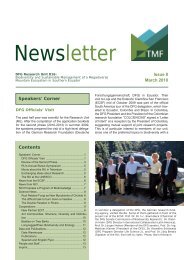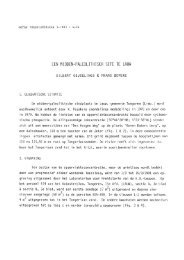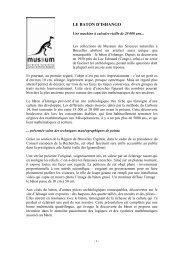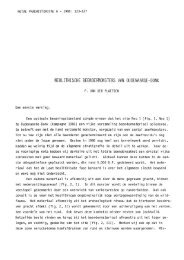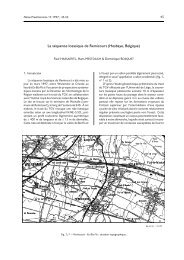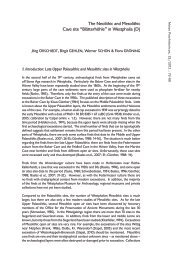Terebratula Daleidensis - Royal Belgian Institute of Natural Sciences
Terebratula Daleidensis - Royal Belgian Institute of Natural Sciences
Terebratula Daleidensis - Royal Belgian Institute of Natural Sciences
Create successful ePaper yourself
Turn your PDF publications into a flip-book with our unique Google optimized e-Paper software.
66 Paul SARTENAER<br />
“Feisternachttal” near Vallendar (Middle Rhine valley)]<br />
are shown on Fig. 2; they are part <strong>of</strong> a collection <strong>of</strong><br />
more than one hundred specimens made by Dr. K.-W.<br />
Wenndorf, and were generously presented to the<br />
author. Inaurita is restricted to the Vallendar Substage.<br />
Some isolated embedded valves suggest that it could<br />
also be present in the lower Upper Emsian Emsquarzit,<br />
Lahnstein Substage, and in “Hohenrheiner Schichten”<br />
<strong>of</strong> the middle Rhine valley, but there is no conclusive<br />
evidence for it.<br />
Only two German geologists identified as R.<br />
inaurita specimens collected from two very different<br />
stratigraphic levels in the Middle Rhine valley. These<br />
are MauReR (1886, pp. 27, 37, 53), and FuchS (1899, p.<br />
68), who reported R. inaurita from the “Cultrijugatus-<br />
Stufe” (= Stufe VIII = uppermost Emsian) at<br />
Laubach and Michelbach), and the basal Hercyniae<br />
Zone (middle Lower Emsian) at Bellsgraben in the<br />
Lorelei area, respectively. MauReR (1896, p. 658)<br />
even suggested that R. inaurita could eventually be<br />
considered as the dominant species (“vorherrschende<br />
Art” <strong>of</strong> what he defines as the lower subdivision [=<br />
Stufen I (“Taunusquarzit”), II (“Hunsrückschiefer”),<br />
and III (“untere Grauwacke”)] <strong>of</strong> the Lower Devonian<br />
on the east <strong>of</strong> the Rhine, and R. daleidensis as the<br />
dominant species <strong>of</strong> the upper subdivision [= Stufen<br />
IV (“Haliseritenschiefer”), V (“Coblenzquarzit”), VI<br />
(“Chondritenschiefer”), VII (“Hohenrheiner-Stufe”),<br />
and VIII “Cultrijugatus-Stufe”)]. The pertinence<br />
<strong>of</strong> these identifications cannot be assessed by the<br />
author.<br />
The “very abundant” Devonian form from<br />
Devonshire identified as Rhynchonella inaurita by<br />
DavidSon (1870, pp. 72, 73-75, 78, 79, 80, pl. V, figs<br />
1-3; 1881, pp. 336, 340, 341, 343, 351-353, pl. 38, fig.<br />
21?, 35, 35a,b), and the Frasnian (sic!) form from NW<br />
Poland (borings) identified as Camarotoechia (C.) ex<br />
gr. inaurita by ŁobanowSki (1968, pp. 768, 774, 775,<br />
783, pl. II, figs 4-5) do not belong to that species.<br />
Description<br />
Shell medium- to medium-large-size, pr<strong>of</strong>ile a rightangle<br />
triangle, strongly dorsibiconvex, and width<br />
always the largest dimension. Shell outline subtrigonal.<br />
Maximum shell width located anteriorly. Ventral<br />
lunulae much lower than the dorsal ones on account<br />
<strong>of</strong> the convexo-concave ventral valve; these posterolateral<br />
concavities, also called ears, may extend as far<br />
as mid-length and are separated from the flanks proper<br />
by ridges that are well pronounced in the umbonal<br />
region. One, exceptionally two, faint costae present in<br />
the lunulae.<br />
Anterior and antero-lateral commissures deeply<br />
serrate, postero-lateral commissures only slightly.<br />
Apical angle moderately wide. Sulcus and fold strongly<br />
marked, start from beaks. Ventral flanks narrow. Beak<br />
pointed, projecting, slightly to strongly incurved.<br />
Interarea very narrow. Deltidial plates short. Sulcus<br />
deep, widening rapidly, wide at front, with flat bottom,<br />
extended dorsally as a high and clearly delineated<br />
tongue with variable outline (trapeze, semicircular<br />
arch, and gothic arch). Tongue high, recurving slightly<br />
to strongly posteriorly in its uppermost part in the<br />
largest specimens. Crest <strong>of</strong> tongue variously (slightly<br />
to strongly) curved.<br />
Dorsal valve very high, thickest at front margin,<br />
vertical or almost vertical in the umbonal area.<br />
Fold very high, rapidly gaining in height anteriorly,<br />
sometimes a sharp rise near front. Slope <strong>of</strong> flanks<br />
sharply interrupted postero-laterally by the lunulae,<br />
abrupt antero-laterally. Costae few, simple, regular,<br />
high, wide, angular (acute, sharp), starting from beaks.<br />
No parietal costae. Shell thin. Teeth stout, wide, short,<br />
cyrtomatodont, entering the dental sockets vertically in<br />
serial transverse sections. Denticula well developed.<br />
Dental plates slender, subparallel, separated from the<br />
wall by wide umbonal cavities. Delthyrial cavity wide.<br />
Hinge plate undivided. Outer hinge plates narrow.<br />
Septum extending until mid-length. Septalium wide,<br />
deep, with variable shape, median ridge sometimes<br />
present on bottom <strong>of</strong> septalium. Connectivum covering<br />
anterior part <strong>of</strong> septalium. Crura long, raduliform,<br />
aliform in section in their proximal part, walkingstick-shaped<br />
in their distal part, where they are curved.<br />
Dental sockets shallow, bottom wrinkled, inner socket<br />
ridges high. Muscle fields slightly impressed.<br />
Comparisons<br />
Inaequalibellirostrum can easily be separated from<br />
Oligoptycherhynchus by a right-angle triangle pr<strong>of</strong>ile,<br />
a subtrigonal outline, well marked lunulae, a slightly<br />
wider apical angle, a slightly deeper sulcus, a tongue<br />
with variable outline, a higher fold with (sometimes) a<br />
sharp rise near front, acute and slightly higher costae,<br />
a different number <strong>of</strong> median costae, the absence <strong>of</strong><br />
parietal costae; a deeper septalium; longer crura; and<br />
teeth entering the dental sockets vertically in serial<br />
transverse sections (laterally in Oligoptycherhynchus).<br />
Representatives <strong>of</strong> the genus Inaequalibellirostrum<br />
may also reach a larger size.<br />
Inaequalibellirostrum differs from Sapphicorhynchus<br />
SaRtenaeR, 2007 by many features, the major<br />
ones being a right-angle triangle pr<strong>of</strong>ile, a subtrigonal<br />
outline, well marked lunulae, a smaller apical angle, a



